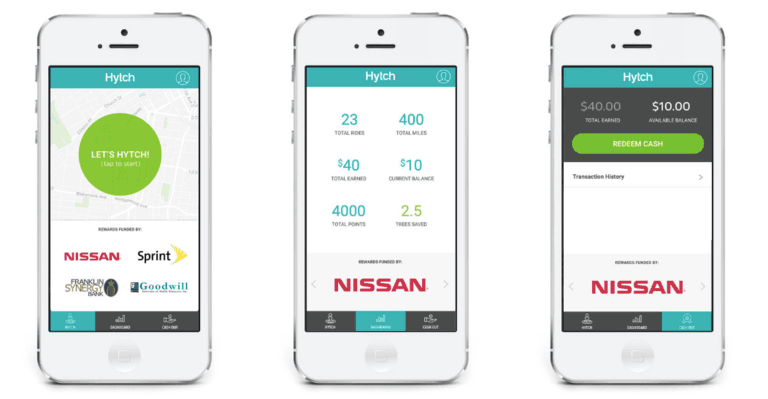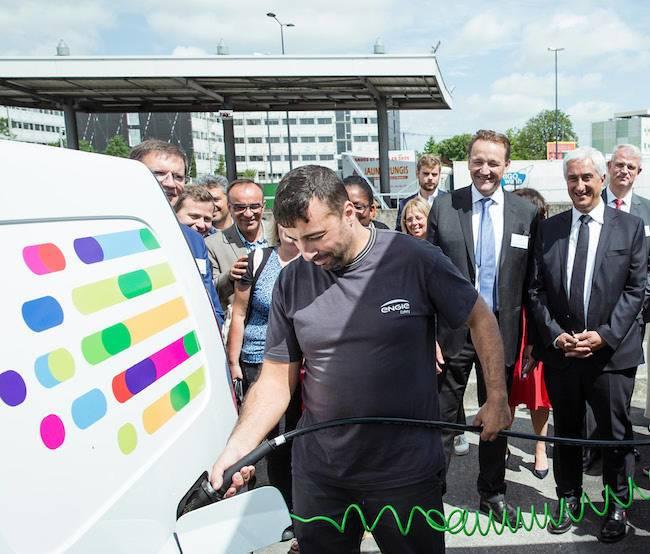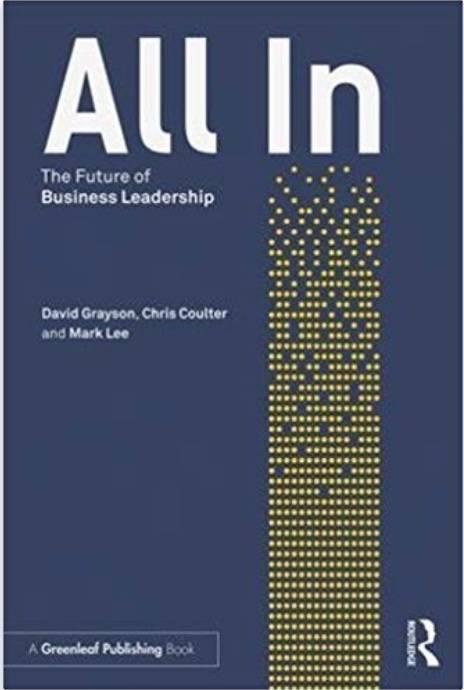It’s Time to Put the ‘Human’ in Human Resources


By Andrea Walton
I was 15 when my first daughter was born with a radial club hand, a disability causing her arm to be angled incorrectly. After 36 hours of labor, I was no longer just a teenager. I was the mother of a special needs child.
I dropped out of high school to focus on caring for her and working to support our family. I went on to earn my GED, and after the birth of my second daughter began college coursework, eventually graduating with Bachelor of Science in Criminal Justice. Urged on by my school counselor, I got my MBA, which opened the door to my first human resources job at a local credit union. I’ve since worked in a variety of Human Resources roles at different companies.
Today, I have my dream job as a human resources manager at Nestlé: I get to help other people achieve their career dreams, no matter what life may throw at them.
My career path is unusual and certainly wasn’t easy, but here I am. I was able to succeed because of grit, hard work, and the support of great people along the way — including my mom, daughters, school counselor, and former managers. Now at Nestlé, I provide that sort of support to our employees, helping them flourish and connecting them to resources that will help them on their journeys.
For me, that starts with building strong relationships with people, grounded in honesty and authenticity. I’m open about my difficult childhood and the obstacles I had to overcome to get where I am today. I even wrote a book about my experiences. And because I’ve been through more than my fair share of hardships, I can empathize with employees as they deal with their struggles. I believe empathy is a vital trait for any human resources professional. During my time at Nestlé, I’ve had employees share details of ongoing health issues, family crises, and divorces to work together find resources to help them cope. They only do that because they trust me.
Often, my job is just to listen and provide comfort to someone during a time of need. But I also connect employees with the wealth of resources Nestlé has in place to assist them and hopefully make their lives a bit easier. With our Nestlé Parent Support Policy, for instance, a child’s primary caregiver can take 14 weeks of paid leave and 12 weeks of unpaid leave to care for their newborn children. One employee used the program after he unexpectedly became the guardian of his infant grandson. The Nestlé Parent Support Policy helps many families navigate what can be challenging stages of life.
Through our Employee Assistance Program and WorkLife Services, employees and their families can access free short-term counseling sessions. We also offer educational materials and referral services to help employees navigate tough parenting or elder care situations.
We provide these benefits, and other supports, because we know Nestlé is only as good as the people who work here. Work is just one aspect of our very complex lives, and the best companies understand that employees will only be invested in the company if the company is invested in them. As our CEO Steve Presley says, “Nestlé’s recipe for success comes down to one thing: people.” If we want our employees — and our business — to succeed, we need to make sure they have the support and tools they need to do so. Our benefit programs do just that.
That’s why I love my job. By being kind and present, and connecting people with resources, I’m helping Nestlé employees to do what I was able to do — navigate life, and work, so they can thrive.
Andrea Walton is Manager of Human Resources at Nestlé USA
Photo: Andrea Walton / LinkedIn
Originally published on Medium and distributed by 3BL Media
Friday Twitter Chat with Monsanto: #BiodiversityandAg, Friday June 22, 11:00am ET


It's National Pollinator Week! To learn what one global agricultural company is doing on this front, please join us for a LIVE 1-hour Twitter chat with Monsanto - long a topic of interest here on TriplePundit - and the Keystone Center on #BiodiversityandAg. This is an important issue, especially considering the role pollinators have in the food industry’s global supply chain.
The chat, hosted by 3BL Media and TriplePundit, is this Friday, June 22, at 11 a.m. ET / 8 a.m. PT / 4 p.m. BT.
Participants in this Friday’s Twitter chat will learn how modern agriculture has harnessed the latest science to protect and support biodiversity - providing farmers with the tools that can help them conserve resources while also supporting local plant and animal species.
The upcoming Twitter chat on Friday, June 22, at 11 a.m. ET offers you an opportunity to discuss how biodiversity and agriculture are connected and crucial for sustainable development worldwide.
Join 3BL Media (@3BLMedia) and TriplePundit (@TriplePundit), along with the following panelists:
- Gabriela Burian (@gpburian), Sustainable Agriculture Lead, Monsanto, and Co-chair of the Climate Smart Agriculture group at the World Business Council of Sustainable Development (WBCSD)
- Pam Bachman (@PamelaBachman), Monsanto’s Environmental Strategic Engagement Lead
- Aimee Hood (@achood4mu), Regulatory Communications Lead at Monsanto
- Christine Scanlan (@CScanlanKPC), President of The Keystone Policy Center, a Colorado-based nonprofit that seeks shared solutions to agriculture, environment, energy, education, and public health issues
- What National Pollinator Week and biodiversity means to the global agricultural sector
- The role women across the world can have in promoting the ties between agriculture and biodiversity
- Steps Monsanto and its partners are taking to reestablish habitats for honeybees, native bees, monarch butterflies and other pollinators
- How the agricultural sector can push sustainable development forward while aligning with the United Nations’ Sustainable Development Goals (SDGs)
Tips to get the most out of the #BiodiversityandAg Twitter Chat:
- Follow the main participants and #BiodiversityandAg hashtag
- Submit questions before the event to promote a more dynamic discussion
- Use the #BiodiversityandAg hashtag on comments that you want to share with the community
- Share tweets you think your followers will appreciate
- Follow interesting participants during and after the chat
Again, be sure to follow this chat using this hashtag, #BiodiversityandAg.
Bring your questions to the Twitter chat, and our panelists will answer as many as possible.
When: Friday, June 22, at 11 a.m. ET / 8 a.m. PT / 4 p.m. BT.
Where: On Twitter, following the hashtag #BiodiversityandAg.
Learn more here about Monsanto's Twitter Chat here.
Hytch Makes Carpooling Pay in Tennessee


Mark Cleveland understands how hard it can be to get people and companies to make sustainable choices. The startup he founded, Hytch, has a solution that's taking off fast: cold hard cash. To put it simply, Hytch pays people to carpool, or otherwise team up on their daily commutes. Since launching in February of this year, the company has logged an impressive 2 million miles of shared rides in the state of Tennessee and signed up more than 6,000 participants. It's all made possible by the sponsorship of corporate partners looking to help employees and their communities make better, more efficient commuting choices.
Hytch initially launched with Nissan as a sponsor. The carmaker operates a sizable factory in Smyrna, Tenn., where employees make long commutes, typically driving solo from as far as an hour away. Long commutes are costly in monetary terms but also in employee wellbeing, carbon footprint, congestion and many other ways. Making commutes easy and cheaper could go a long way towards improving employee satisfaction, retention, productivity and ultimately the environmental impact of the entire company.
Nissan and their staffing agency signed up to offer anyone in the state of Tennessee a penny a mile if they teamed up with someone for a ride. They offer five cents a mile during certain commute hours. There are obvious marketing benefits to the move but Nissan was also interested in learning about the behavior of people that choose to share rides - smart thinking as the future of mobility continues to evolve. A shared ride is also a carbon neutral ride thanks to offsets purchased and retired by Hytch. In fact, when more than two people ride together the ride is arguably carbon negative.
The way it works is simple. Anyone can download the app to their phone and connect with colleagues and friends. The app matches drivers with riders and off you go. As long as the two phones remain moving in close proximity, the ride can be credited as shared. It even works if folks team up to ride the bus or other transit means, but there need to two or more folks together to make it work.
Why two people? An added bonus of Hytch is that two or more people riding together means social engagement - interaction, discussion of work, and makes the concept inherently viral as folks seek each other out to share rides. There are other unexpected benefits. Drivers with passengers are less likely to experience road rage and tend to be on time more often.
Since the early success with Nissan, additional sponsors have come on board. Each additional sponsor can set their own rules and prices for exactly how payouts work. For example, they might seek to encourage carpooling for an NHL hockey game. One local university is seeking to reduce crowding in parking lots on certain high traffic weekdays, and other companies are keen to simply sponsor things more generally. All the sponsorship adds up so that it's possible for payouts to approach 50 cents a mile under certain circumstances. That adds up to real money, especially if you're in a lower income bracket.
So where do we go from here? The benefits of carpooling - and rewarding people monetarily for doing it - are too numerous to count. From carbon emission reduction to human wellbeing, anything that makes it rewarding to do the right thing is laudable. Ultimately, Hytch offers an organizing principal for the idea that sharing a ride is valuable. The technology simply makes it obvious and easy to demonstrate and track.
With success in Tennessee, and conversations already afoot in neighboring states it's only a matter of time before Hytch's technology spreads.
Behavior Change Lessons from National Geographic’s Planet or Plastic? Campaign


I was very happy to hear about the June issue of National Geographic on plastics, which “looks in depth at how single-use plastic impacts our planet.” What made me even more excited about it was that this issue is part of National Geographic’s Planet or Plastic?, “a multiyear initiative aimed at raising awareness of this challenge and reducing the amount of single-use plastic that enters in the world’s oceans.”
As I started looking into it my mood has changed from happy to sad. It was not just because of the devastating statistics, stories and pictures describing “the global plastic trash crisis,” but also due to National Geographic’s efforts to make a difference, with the goal of educating “audiences around the world about how to eliminate single-use plastics” through its Planet or Plastic? initiative.
These efforts include a Planet or Plastic? Pledge: “Nat Geo is asking audiences around the world to take the Planet or Plastic? Pledge - a commitment to reduce their use of single-use plastic,” and a three-day social media campaign to spread the word about the pledge and the issue. In addition, Laura Parker, who wrote the excellent cover story for this issue, provides a list of six pain-free things you can do to reduce your plastic footprint, including giving up plastic bags, skipping straws and passing up plastic bottles.
So what made me sad here? First, let me be clear - I love National Geographic and admire the important work it does. At the same time, the efforts it shared to change our love affair with single-use plastic reflect a dated approach that probably has a very little chance to make any difference. Now, my beef is not with National Geographic – larger companies struggle to convince consumers to adopt a more sustainable lifestyle, especially when it does not directly concern their health, so why the bar should be higher for Nat Geo? And yet, the fact that what we are offered is to sign a pledge online to carry your own reusable bottle or advice like “Give up plastic bags. Take your own reusable ones to the store” saddens me. In 2018 we should know better. We HAVE to know better.
We are at the age where urgent action is required. We need to be already in an “exponential journey towards a transformation to sustainability,” and therefore we have to aim high, far higher than what we did so far. I don’t claim to have all the answers on how we do it, but in the spirit of Stanford Professor John Arnold, who suggested that “each of man's advances was started by a question….knowing what questions to ask and how to ask them is sometimes more important than the eventual answers,” I’d like to propose four questions we should ask when considering interventions aiming to change consumer behavior:
1) Are you thinking like a startup (aka what’s your 11 star experience)?
When considering how to create interventions that will enable (at least) 100 million people to move to sustainable lifestyles, we very rarely see startup thinking. What I mean is the following - when National Geographic asks you to “give up plastic bags. Take your own reusable ones to the store,” it thinks about the goal of waste reduction (“trillion plastic shopping bags are used worldwide every year”), not about the user experience of using reusable bags.
Startups (not all of them, but many), on the other hand understand that no scaling effort can be made successfully without focusing first and foremost on the user experience. Brian Chesky, the co-founder and CEO of Airbnb, explained this approach in an interview with Reid Hoffman:
“If you want to build something that’s truly viral you have to create a total mindf**k experience that you tell everyone about. If I say, ‘What can I do to make this [product] better?’ you’ll say something small. If I were to say, ‘Reid, what would it take for me to design something that you would literally tell every single person you’ve ever encountered?’ You start to ask these questions and it really helps you think through the problem.
Now, Chesky goes beyond explaining the logic of why do you need to design a great user experience to providing a useful exercise on how to do it – writing down what a 1-, 2-, 3-, and so on star experience using your product will look like, but he doesn’t stop at 5-stars – and go all the way to considering what an 11-star experience may be. Here’s a quick example for a 5-star and 11-star experience using a reusable shopping bag:
5-star experience: I go to the supermarket. I don’t need to remember or worry about bringing a bag with me because the supermarket provides me as many reusable bags I need at the checkout counter – it is free if I spend more than $100 a month on groceries (if not, I’ll be charged $1 per bag at the end of the month). The bags are stylish, sturdy, and easy to carry around and fold nicely. If I bring used ones back I get a discount coupon!
11-star experience: When I enter the supermarket I receive a smart reusable bag that can connect directly with my smart refrigerator and send to my phone a list of what I need to buy. To ensure I don’t forget anything, it will change its color from red to green once I’m done with the list. When I’m done, I don’t need to wait in line for the checkout as the payment is done automatically Uber-style.
As Chesky explains, the point of this exercise is that while the 9-, 10-, 11- star experiences are probably not feasible yet, they allow you to expand your imagination beyond the 5-star experience and look for a sweet spot between “getting a free reusable bag at the supermarket” and “a smart bag that helps you shopping.” You have to almost design the extreme to come backwards, Chesky suggests.
Bottom line: While adopting this mindset does not guarantee success, avoiding this mindset almost certainly guarantees failure if you are interested in reaching out to large audiences.
2) Are you considering the A.C.E model?
In their new book “New Power: How Power Works in Our Hyperconnected World--and How to Make It Work for You,” Jeremy Heimans and Henry Timms offer a new framework including three design principles to effectively spread ideas in a world where people want to take a more active role instead of just consuming ideas.
The principles are: Actionable (“the idea is designed to make you do something”), Connected (“the idea promotes a peer connection with people you care about or share values with”), and Extensible (“the idea can be easily customized, remixed and shaped by the participant”). Heimans and Timms make the case that these principles can explain the success of initiatives and campaigns like ‘Giving Tuesday’ or ‘The Ice Bucket Challenge’, as well as social movements like #MeToo.
The A.C.E framework is truly about understanding the new dynamics and trends that shape the world in the 21st century and the need to contextualize efforts to impact people accordingly. As Heimans explains “New power models ask us to do more than just consume and comply. They ask us to share content, to adapt that content and spread it, to affiliate in new ways.”
Bottom line: “The future” according to Heimans and Timms “will be won by those who can spread their ideas better, faster and more durably.” To do so you need to understand not just content, but also context of an “open, participatory peer-driven” environment and how to use it to your advantage.
3) Are you using behavioral science?
Behavioral science is a powerful framework when it comes to changing consumer behavior. “Could we use the insights from the last fifty years of behavioural science to arm ourselves, and those around us, with a better set of techniques and skills to follow through on choices made, and achieve the things we want to?” David Halpern, Director of the UK Behavioral Insight Team asks in his forward to the book “Think Small: The Surprisingly Simple Ways to Reach Big Goals” by Owain Service and Rory Gallagher.
“I think the answer is ‘yes’,” Halpern answers his own question, and I agree with him. In 2018, we should not just ask people to change their behavior and adopt new habits without using the know-how we have gained in order to provide them with a roadmap on how to do it. With the need in exponential transformation in mind, I do not see any reason to ignore decades of behavioral science research that are at our disposal and can “inform how we could do things differently,” as Service and Gallagher suggest.
Service and Gallagher offer in their book a framework that is an example of such a roadmap, helping not just to provide guidance, but also to adopt a mindset “that focuses on getting the small – and often simple – details right, that will set you on the path to achieving big goals.” I’ll give an example how Service and Gallagher’s 7-step framework may be used when considering the goal of eliminating single-use plastic bags.
Step 1: Set 1. Choose the right goal – reducing my plastic footprint by eliminating the use of single-use plastic bags
- Set a specific target and deadline – eliminating the use of disposable plastic grocery bags (not including the small ones used to package fruit and vegetables – this will be the next step) until the end of 2018.
- Break it down into manageable steps – record my current use of plastic bags and set up a clear reduction plan by the first week of June. Use a journal to write down how many single-use plastic bags I use every week. Follow up on my progress on the first week of July-December and make changes in my plan if needed.
- Keep it simple – Try to do my grocery shopping only on Saturday and Sunday.
- Create an actionable plan – I will have 10 reusable bags at home and 2 more in my car. Every time I go to do grocery shopping I will take 5-6 bags with me. If somehow I find myself at the store without a reusable bag I’ll buy one.
- Turn the plan into habit – I will put the reusable bags at home next to my keys and wallet, so I remember to take all three (keys, wallet, bags) when I go for shopping.
- Making a binding commitment – I will stop using disposable plastic grocery bags by December 31, 2018.
- Make it public and write it down – I’ll share it on my social media channels.
- Appoint a commitment referee – I’m appointing a good friend to check on my progress.
- Put something at stake for a headline objective – I’m buying two tickets for a Jerry Seinfeld comedy show in January 2019 – if I don’t meet my goal I’ll give the tickets to someone else.
- Build good habits through smaller rewards – I will listen to Team Human, one of my favorite podcasts when I’m shopping.
- Ask for help – I’ll ask my wife to remind me about the bags every time before I go to buy groceries.
- Tap into your social networks – I’ll look for a friend or colleague who would like to take the same challenge!
- Join a group – I’ll look for a meetup group of people interested in using reusable shopping bag. If there isn’t one yet in NYC, I can start one.
- Know where you stand in relation to your goal - I will keep a journal, where I record my weekly use of plastic bags.
- Make feedback timely, specific and actionable
- Practice with focus and effort
- Test and learn
- Reflect and celebrate
4) Upstream, downstream, or both?
These could actually be the first questions you need to ask yourself: Why changing consumer behavior in the first place? Is this the most effective leverage point to make a systemic change? These questions are grounded in systems thinking and in acknowledging that some places to intervene in a system are more effective than others.
Take for example the news I’ve read last month: “P&G's research found that washing at 40C uses more than double the amount of energy as washing in a cold and quick cycle.” This news item was related to P&G’s ‘Long Live Fashion’ campaign, “which encourages consumers to switch to colder and shorter washes and to use both detergent and fabric softener.” The campaign offered consumers a 3-step formula to increase the lifetime of their clothes, while reducing their environmental impact: 1) Use a High Quality Liquid Detergent like Ariel Pods (Ariel is a P&G brand) 2) Wash in Cold + Quick cycles, and 3) Add Lenor to the Drawer (Lenor is a P&G fabric conditioner).
P&G’s global vice president for fabric enhancers Bert Wouters is quoted saying: “Sourcing, production and recycling are the focus of a great deal of attention in fashion, but the impact of extending the life of clothes during the so called ‘use phase’ has been largely ignored so far. We are delighted that the ‘Long Live Fashion Formula’ can help reduce the environmental burden of fashion.” Now, going back to the question of effective leverage points, my question to P&G would be if this intervention can be as or more effective than other interventions, such as partnering with washing machines manufacturers to design washing machines that have only quick and cold cycles?
Research suggests that may be the case. In their 2006 paper ‘Interventions to Break and Create Consumer Habits’, Bas Verplanken and Wendy Wood explore which behavior change interventions are more effective in creating new habits (defined as “a form of automaticity in responding that develops as people repeat actions in stable circumstances”). They differentiate between two types of behavior change interventions - downstream (“interventions that provide people with information about the right thing to do or that increase their understanding about how to perform a behavior”), and upstream (“do not treat problems after they occur but rather are designed to prevent undesired outcomes and maintain optimal lifestyles”).
In general, they don’t find downstream interventions to be very effective: ”As we explain, because habits are linked to recurring performance environments, they are not easily changed with only downstream, informational interventions… strong habits are associated with simple, shallow decision rules. Essentially, people with strong habits possess motivational and informational biases that reduce the likelihood that they will receive and evaluate favorably new, counterhabitual information. These biases reduce the impact of informational campaigns and help maintain existing behavior patterns.”
However, the researchers suggest that downstream interventions plus context change (think for example about moving to a new area or changes in the social environment) may be effective because “the changes in context render people with strong habits vulnerable to new information. Similarly, they make the case for the effectiveness in some cases of upstream interventions, such as taxes and economic incentives.
In summary, Verplanken and Wood write:
“Essentially, to alter old habits and establish new ones, the critical ingredients for any interventions include (1) changes in the old performance environment that disrupt existing habits coupled with (2) opportunities or experiences that encourage performance of the desired response.”
This multi-layered approach to behavior change, which is also reflected in other approaches to change making makes the case that considering downstream interventions without upstream interventions may not be effective when it comes to habits like using single-use plastic bags on using the washing machine. They don’t necessarily suggest that National Geographic or P&G will give up efforts on changing consumer behavior, only that they understand that if they ignore the context these efforts will be fruitless in the end.
Bottom line: Applying systems thinking is key to any successful behavior change intervention. When it comes to reducing our use of single-use plastic, the consideration should be how to create the most effective balance between upstream and downstream interventions to trigger the change we want to see.
“Faced with a world drifting rapidly towards catastrophe, it seems to me that we need this sense of a designer’s realism and optimism more then ever. We must see the problems, and we must think that in spite of everything, it is possible to solve these problems. We must find solutions,” Ezio Manzini writes. The four questions I suggest for consideration are grounded in this approach, reflecting both realism and optimism that we can still move the needle. At the same time they are also about pushing the envelope and taking bolder approaches to changing consumer behavior. In 2018 this is not only a choice, but an obligation of anyone inspiring to make our life more sustainable.
Image credit: Adam
Leading Gas Company Launches Hydrogen Fuel Cell EV Fleet


France-based ENGIE is best known for its leadership role in distributing, storing and importing natural gas in Europe. So, when the company launched a fleet of 50 hydrogen fuel cell utility vehicles last week, it would be natural to assume that the hydrogen is coming from the usual source, namely, natural gas.
Guess again. The project comes under the umbrella of one of ENGIE's numerous subsidiaries, ENGIE Cofely, which is centered on energy efficiency and sustainability. If the fleet is a bottom line success, it could be the beginning of a long, slow -- or rapid, as the case may be -- global transition to renewable hydrogen.
Renewable Hydrogen For Fuel Cell EVs
For those of you new to the topic, fuel cell EVs run on electricity, just like their battery-powered cousins. The difference is that fuel cells generate electricity on board through a chemical reaction between hydrogen and oxygen.
If that on-the-go factor sounds like an advantage over today's generation of battery EVs, it is. A tank of hydrogen takes minutes to fill up, far faster than a typical full battery charge.
On the downside is that thing about natural gas, but with the advent of low cost renewable energy, fossil hydrogen could be on the way out. Among the many pathways to renewable H2 is electrolysis, in which an electrical current is used to "split" water.
The new fuel cell EV fleet will consist of 50 hydrogen Renault Kangoo vans, which ENGIE Cofely will deploy to service buildings it has under contract in the Ile-de-France.
Here's the money quote:
The definitive installation will produce hydrogen on site with an electrolyser powered solely by renewable energy. The hydrogen station is designed, manufactured and integrated by McPhy, a leader in production, storage and hydrogen distribution equipment that serves the energy transition.
From Natural Gas To Renewable Hydrogen
Parent company ENGIE is among the growing ranks of legacy fossil companies acknowledging that the age of oil and gas is drawing to a close.
That doesn't necessarily mean demand for oil or gas will evaporate entirely, but it does mean that energy companies will need to diversify into renewable energy if they want to stay afloat -- and do right by their investors.
In a press release announcing the new fuel cell fleet project, ENGIE states that it "positions itself as a forerunner in this revolution:"
...ENGIE owns, through its subsidiary GNVert, more than 150 alternative fuel stations in France. ENGIE is also an international leader on the recharging infrastructures market for electronic vehicles, with a presence in 30 countries and 980 cities around the world.
The company also notes the growing role of power-to-gas technology, which deploys renewable hydrogen as an energy storage platform for wind and solar power. In other words, renewable hydrogen acts as an enabler for integrating more wind and solar into the grid:
...renewable hydrogen is one of the missing links needed to construct a more sustainable energy system. This conviction led the Group to create in the beginning of 2018 a business unit with a global vocation dedicated to this market in the making.
It looks like ENGIE has decided to go head-to-head with the similarly named Enel Group, a company that has been in the vanguard of the energy transition. That's quite a sea change for ENGIE, which was the target of environmentalists' wrath in the runup to the 2015 Paris Agreement on climate change.
It remains to be seen if the new "business unit" will ease the company out of its fossil dependency. However, given the goings-on at last week's meeting of the G7 in Canada, stability of price and supply would be a major and growing advantage for renewable hydrogen over its fossil-sourced cousin.
Gilding The Fuel Cell EV Lily
Circling back to that new fleet project, as an expert in efficiency ENGIE Cofely is also looking to leverage autonomous capabilities to cut costs.
Reduced fueling time is one element the company anticipates. The renewable hydrogen company McPhy is providing its "McFill" filling station for the fuel cell fleet, and is claiming a filling time of less than five minutes. There may be other efficiencies related to autonomous driving and connectivity, too.
ENGIE Cofely is also responding to a direct bottom line incentive for switching to zero emission vehicles. The fleet will fuel up at the Rungis International Market, which bills itself as the biggest fresh produce market in the world. Toll-free driving is available to "clean" vehicles as part of a broader strategy to cut down on pollution:
With a stream of more than 25 000 vehicles per day, the Rungis Market, which offers free motorway toll to all clean vehicles that use the station for refueling, is a strategic location for the development of green mobility for freight transport in Ile-de-France.
Rungis Market has also embarked on a broader sustainable development program to address transportation emissions and other issues.
Other partners in the ENGIE Cofely fleet venture include Symbio, which converted the vehicles for fuel cells and enhanced autonomous operation, and Alphabet, which owns the vehicles and is renting them to ENGIE Cofely. Financial support was provided by the European Fuel Cells and Hydrogen Joint Undertaking.
Converting Fleets To Clean Power
Speaking of Alphabet, the Alphabet in this fleet project is not to be confused with the parent company of Google. Alphabet is BMW's fleet management subsidiary. It launched in Europe in 1997 and within 10 years it grew over the 250,000 vehicle milestone. In about half that time -- from 2007 to 2013 -- it doubled to more than 500,000 vehicles, and by 2015 Alphabet was billing itself as one of the five largest fleet providers in the world.
In 2010, Alphabet began dipping into the sustainable driving market with a car sharing service called AlphaCity, aimed at enabling companies to expand beyond conventional carpooling. It also began offering clients offsets for carbon emissions in the form of environmental projects.
The company currently offers an electric vehicle option, and if all goes well with the ENGIE Cofely fleet, it looks like renewable hydrogen could be the next addition to the company's sustainable mobility menu -- with the potential for a significant impact on the global marketplace.
Fuel Cell Mobility For The USA
ENGIE Cofely already has a footprint in the US -- last year, for example, it entered into a 50-year, $1.65 billion contract with Ohio State University to help the school meet its climate goals -- and if the new fuel cell EV fleet is successful, there is a good chance the venture could be replicated here.
Toyota is among the companies tapping into the California market for early fuel cell EV adopters, and the US Department of Energy is supporting renewable hydrogen and the fuel cell EV market through foundational research and public-private partnerships.
Fuel cells are emerging into the US logistics sector thanks in part to Amazon, and at least one US company, the startup Nikola, has introduced plans for long haul semi trucks powered by fuel cells.
In the latest development, last week Nikola announced that it is looking to hire "top talent" to staff its new electric drive and fuel cell R&D center in Arizona.
Nikola is still in the pre-order phase, but a recent commitment of up to 800 fuel cell vehicles by the global beer giant Anheuser-Busch indicates that the company's business model is on track.
Photo: via McPhy.
Hawaii Sunscreen Ban: Environmentalists Push for More Green Products


The makers of chemical sunscreens are feeling some extraordinary heat these days. Last month Hawaii’s legislature passed a bill that would outlaw the sale of sunscreens that use oxybenzone or octinoxate – the two key ingredients that help products reduce UV exposure when they are applied to the skin.
That’s because according to clinical research, the two chemicals, while effective, also come with a host of environmental risks.
Studies conducted in Spain, Italy, Israel and Iran have found that the two additives are destructive to delicate marine ecology like coral reefs. A 2015 study published in a toxicology journal reported that exposure to the chemicals caused deformities in young coral and was responsible for the die-off of coral in Hawaii and the U.S. Virgin Islands. Other studies suggest similar results.
Research also suggest that the additives have health implications for humans, as well. Findings indicate oxybenzone may be an “endocrine disruptor” in humans as well and affect growth, development and immunological functions in children and adults.
In recent years, the Environmental Working Group (EWG) has spearheaded efforts to educate consumers about the findings. It hosts a yearly survey of non-chemical, or mineral-based sunscreens and publishes the results on its website. It’s also been advocating for banning the use of oxybenzone and octinoxate and helped to lobby for the recent bill in Hawaii.
While Hawaii Gov. David Ige hasn’t said whether he will endorse the ban, the industry association, Personal Care Products Council isn’t taking the threat to the industry lightly. It’s called the bill unfair and said it’s based on “weak science.”
Alexandra Kowcz, PCPC’s chief scientist claims that oxybenzone is “one of the few Food and Drug Administration (FDA) approved ingredients that provides safe and effective broad-spectrum protection from UV radiation, and has been approved for use since 1978.”
In fact, there has been increasing pressure on the FDA in recent years to review and approve other alternative sunscreens that don’t use these two chemicals. In 2014, Congress passed the Sunscreen Innovation Act, which required the FDA to give consideration to sunscreens that don’t use the two chemicals. A year later, the federal agency reported that companies applying for approval had submitted inadequate information to warrant acceptance by the FDA and it had been unable to approve alternative products.
Still, it’s interesting that many of the sunscreens that aren’t labeled endocrine disruptors have been on the market in the EU and Canada for years. And some of them are now beginning to gain prominence in the U.S., in part at the recommendation of rheumatologists and other specialists that treat patients with sun sensitivity.
That’s because an increasing number of heart, arthritis and anti-depressive medications have been found to produce photosensitivity as a side affect. Diseases like Lupus and mixed connective tissue diseases are also increasing the call for “green” sunscreens that can be worn around the clock and don’t come with warnings of toxicity.
Hawaii’s ban: A growing movement to protect the environment
Hawaii’s bid as the first state in the country to ban chemical sunscreens in its stores isn’t really a global “first.” Several other regions that rely on environmental tourism reportedly have also banned sunscreens from their waters. The Great Barrier Reef and various tourist destinations in the Philippines, Mexico, and French Polynesia are among the growing number of locations that are attempting to encourage consumers to leave certain sunscreen products at home.
For the U.S. suncare industry, which had a market value of $185 bn in 2016 and whose biggest sellers were all chemical sunscreens, that’s a huge concern that may yield its own momentum to change. As Ken Cook, president of EWG, told Chemical Watch, “[The suncare] industry has not yet stepped up to the plate. “Now consumers are forcing change.”
Flickr image: Joe Shlabotnik
The Corporate Responsibility Summer Must-Read for the C-Suite


Move over, “Green Giants.” You’ve got company.
The section of my bookshelf reserved for thoughtful contributions from corporate responsibility professionals has just welcomed “All In: The Future of Business Leadership,” written by David Grayson, Chris Coulter and Mark Lee.
While Freya Williams illustrated the powerful benefits sustainability brought to nine businesses profiled in her book “Green Giants” in 2015, this new publication acts as a primer for any C-suite executive in need of a concise yet convincing argument for embracing the triple bottom line – people, planet and profits.
“’All In’ provides a critical contribution to why and how business needs to commit to sustainability at pace and scale in the coming years,” wrote Liz Maw, CEO of Net Impact. “This should be required reading for the next generation of business leader.”
Tracing the history of corporate responsibility through three eras – Harm Reduction, 1997-2005; Strategic Integration, 2006-2015; and Purpose-Driven, 2016 to present – Grayson, Coulter and Lee predict the arrival of a “Regenerative Era.”
“We believe that as we get closer to 2025, there will be a critical mass of companies committing to a circular economy or closed-loop approach to business, as well as a redesign of business models to optimize the economic, environmental, and social positives of all they do,” the authors wrote.
Grayson is the former managing director of Great Britain’s non-profit coalition of companies Business in the Community and emeritus professor of corporate responsibility at the Cranfield School of Management. Coulter is co-CEO of the Toronto-based research firm GlobeScan. Lee is executive director of the consultancy SustainAbility.
During Sustainable Brands, where Coulter graciously gave me a copy of “All In” to read on my plane ride home, we taped a video interview about the book and the growing Brands Taking Stands movement.
“We think that advocacy is speaking out and speaking up for sustainable development and social justice,” said Grayson. See the full interview here.
Hamburgers Go Climate Positive


“Houston, we have a climate problem,” Kaj Török explained when he took the stage at Sustainable Brands this week. He was talking about the urgent need to reduce emissions in order to offset the worst impacts of climate change. Beef consumption is sadly a big part of that problem. The David Suzuki Foundation states:
"Livestock production accounts for 70 percent of all agricultural land use, occupies 30 per cent of the planet’s land surface and is responsible for 18 per cent of greenhouse gases such as methane and nitrous oxide.Growing animals for food is also inefficient. It takes about five to seven kilograms of grain to produce one kilogram of beef. Each of those takes energy and water to produce, process, and transport."
The American hamburger, a classic comfort food, is slowly killing us environmentally. But Max Burgers has figured out a simple, elegant way to offset the climate impact of each burger. And this methodology is replicable for any product in any industry and it doesn't have to cost an arm and a leg. The straightforward methodology is this: conduct a comprehensive carbon impact assessment, reduce what you can and purchase carbon offsets to account for 110% of the rest.
Deep green sustainability enthusiasts might quibble with this formula: indeed, offsets aren't as good as not emitting in the first place, and quality of the offsets matters. But this system is simple and straightforward and flexible enough for any product in any industry.
Török issued a challenge to the 1500 attendees at Sustainable Brands: replicate the model with other products, and share them with the larger sustainability community by tagging them at clipop.org, a currently very small registry of climate positive products. Max Burgers is available at approximately 100 outlets in Sweden, Poland, Norway, Denmark, and Egypt.
The team at Max Burgers has quite a comprehensive approach to product stewardship and environmental impact, with the carbon positive program at the very end of a long line of adjustments:
- The chain is the only Swedish national burger chain that uses Swedish meat. It costs about 30 percent more than EU meat, but has 25 percent less embedded carbon than EU meat, due to Swedish grazing practices. This decision results in a modest increase in the cost of the burger -- 6 percent over the competition, but increased demand from the LOHAS market (Lifestyles of Health and Sustainability) made up the difference.
Max Burger also offers a variety of tasty burger options that use chicken, fish, and plant-based protein to make it easy for customers to eat less meat overall.
Török tells me that these changes have "attracted new clients and turned some meat lovers into green burger lovers." Max Burgers' transformation has mirrored a sea change seen qcross the company. In the last year, Swedes have reduced red meat consumption by 2 percent, Max customers have reduced red meat consumption 13 percent.
As usual Americans will be playing catch up to our Nordic compatriots when it comes to sustainability -- and catch up we must.
Carbon Engineering: New Technology Slashes Cost of Gasoline from Air


A Canadian company is en route to developing a marketable – and cheap – way to produce carbon-negative gasoline.
Carbon Engineering, based in Squamish, BC, demonstrated in December that it had succeeded in synthesizing a mixture of gas and diesel using only carbon it had captured from the air. The hydrogen for the process was split from water using electrolysis produced with renewable energy.
But this month it did one better: using what is called direct air capture technology (DAC), the company reportedly has figured out how to slash the cost of capturing carbon from the air that it has used in synthesizing fuel.
The results of the research were published online on Thursday in Joule, a scientific publication that focuses on sustainable energy as a peer-reviewed article. David Keith, a Harvard University professor and founder of Carbon Engineering, led the investigations to find a “a scalable and cost-effective solution for removing CO₂ from the atmosphere.”
The data, say the team “prove[s] that CO2 can now be captured from the atmosphere for less than $100 USD a ton.” Previous cost estimates for that technology placed it out of reach at about $600 a ton.
But that exorbitant cost, quoted by Princeton University mechanical engineer Robert Socolow, was based on technology that is now considered ineffective. According to a report co-chaired by Socolow and BP chemist Michael Desmond in 2011, building a unit that could offset the emissions of a 1,000 kWh power plant “would require 30 kilometers of equipment” to operate.
Keith’s technology is designed to convert CO2 in the atmosphere to fuel. The Air to Fuel technology, which the company has been developing since 2009, uses giant fans and other mechanics to “scrub” the CO₂ from the air and produce fuel sources from the carbon, in the same way that fossil fuel carbon is converted to gasoline. It then returns the scrubbed air to the atmosphere.
“[Carbon Engineering's] vision is to reduce the effects of climate change by first cutting emissions, then by reducing atmospheric CO₂,” explained the company's CEO Steve Oldham, who said the fuel is “fully compatible” with existing engines and provides the commercial sector with the advantages of reducing carbon emissions.
Still, the company has a ways to go to convince buyers to support the new product. The authors admit in their report that “the feasibility of DAC has been disputed” and at times, lumped in with other technological ideas for addressing climate change that seem illogical or too expensive.
That is in part, say the authors, “because publications have not provided sufficient engineering detail to allow independent evaluation of costs.”
“This isn’t going to save the world from the impacts of climate change,” Keith told the BBC, but it is another significant step in advancing DAC technology. What began in the 1990s by a Columbia University theoretical physicist as an effort to mimic the tree’s resourceful use of carbon, is now a tangible reality that may soon offer another alternative to fuels made from the earth’s priciest reserve of carbon.
Flickr image: Benny Mazur
Is Outsourcing Right for Your Company? 3 Tips to Guide Your Decision


By Lee Rhodes
Entrepreneurial growth brings excitement and opportunity. With each next step comes questions to answer and potential directions to take.
Take outsourcing, for example. An estimated 300,000 jobs are outsourced from the U.S. annually. On paper, aligning with a third-party manufacturer can provide a lot of value. It’s cost-effective and can focus your team’s big-picture initiatives.
The question, then, becomes whether it’s right for your company. For sustainable brands, does outsourcing connect with your green goals and vision? And will it diminish your bottom line to the point that your company can’t reach its bigger benchmarks?
Sustainability is a core value that must emanate from every part of your brand. Outsourcing should connect with that green value system while simultaneously bettering the bottom line.
Bring in a Helping Hand
Balancing your entrepreneurial and environmental goals through outsourcing is a tricky task. Here are three simple steps to guide your thinking:
1. Know yourself. Any decision your brand makes should have a clear through line to your company values. Authenticity is key and can never be regained once lost. In fact, 54 percent of customers distrust brands, which makes transparency even more important. Your customers should clearly recognize sincerity in your outsourcing plan.
In the early days of my company, glassybaby, we outsourced an order of 150,000 glass votives to a facility in China. But when they came back, they weren’t what we’d envisioned. The glass was dirty, and the colors were dim. What’s more, they didn’t fit with our American-made products philosophy. We take pride in our homegrown products and couldn’t reconcile the fact that so many were produced overseas. The pieces remained in palettes for nine months before we gave them away.
The experiment proved how important our values were to us. We take pride in our products being efficiently made and unique in presentation. To hold on to that authenticity, we decided to pay more to bring manufacturing back in-house with artisan glass blowers. As you deliberate your outsourcing options, keep your core values and goals in front of you. That way, every decision you make — like whether to outsource manufacturing — will fit into your authentic story and will engage your customers.
2. Choose your suppliers like you choose employees. In a MicroSolution survey, 78 percent of global companies said they value their relationships with their outsourcing partners. Outsourcing isn’t a one-brand job. Should you do it, partner with companies that are as passionate about it and your goals as you are. Just as you want employees to feel deeply about your core values, outsourcing partners should be similarly inclined.
When we moved production back to the United States, we continued to outsource some work, like packaging and production of our tea light candles. But we made sure those partners were family-based companies like ours who shared our values — including our value of sustainability.
When we vet our suppliers, we consider only companies that share our passion for sustainability. Each year, more than 500 new chemicals are introduced into the environment; these elements deeply affect the natural world, animals, and people. With this in mind, we do a thorough examination with potential partners to ensure their materials, processes, and supply chains coincide with our sustainability values. If one variable doesn’t align with ours, we go elsewhere.
You should view outsourcing as a collection of relationships that need to be maintained. These people are joining your brand’s family. Make sure they’re kindred spirits in sustainability and all other facets of your business.
3. Take cues from your buyers. In a Salesforce study, 66 percent of customers said they’ll leave a brand if they feel like “just a number.” Your most loyal customers believe in your values and are the reason you do what you do. They wholeheartedly believe in your mission and know which decisions make sense for your storyline. Take cues from them when forming your outsourcing strategy.
We knew bringing our sourcing and production back to America would be a popular move with our customers. U.S. consumers are increasingly concerned about where their products originated. Many customers choose to buy from local, sustainability-focused brands; this has led big and small businesses alike to focus brand stories more on American production.
Our American-centric outsourcing strategy ended up being a hit with our customers. The move made sense to them as part of the brand’s story, which established a deeper bond with our loyalists. Customer feedback is the fuel that drives product and brand evolution. If buyers appreciate domestic manufacturing, prominently feature it in your company’s value system.
The overarching question you need to ask about outsourcing is why: Why are we doing this, and why will it improve our overall brand? Foundational decisions from the heart lead businesses to success and create a lasting brand. With each step forward, small or big, it’s always important to remember the intention you created from the beginning.
Lee Rhodes founded glassybaby in 2001. She developed the idea for glassybaby’s one-of-a-kind votives and drinkers with the core mission of helping cancer patients she met during treatment afford basic needs such as bus fare, childcare, or groceries. Ten percent of the company’s entire revenue goes toward a charitable organization.
Photo: Glassybaby.